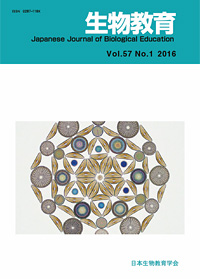
- Issue 1 Pages 2-
- |<
- <
- 1
- >
- >|
-
Tsubasa Hidaka, Tetsuro Tanzawa2016Volume 57Issue 1 Pages 2-12
Published: 2016
Released on J-STAGE: October 29, 2018
JOURNAL FREE ACCESSChanges of aims, objectives, contents of learning, and teaching approach of American high school physiology in the 19th century were examined historically in this study. Textbooks and publications of those days, and literature concerning historical research of American science education were used for the analysis. As a result, 19th century was divided into three sections, early 19th century, mid of the century, and end of the century, based on the above examination. The following points of view which characterize each section were identified; change of instructional materials from entire animal kingdom only to the human, experimental approach in teaching, description of relationship between physiology and human life, learning contents about the harm of tobacco and alcohol, religious and moral aspects and so on. These changes were interpreted by such factors as unsanitary living conditions, popularization of temperance thought, and commitment of educational administration to learning contents. Finally, it was discussed that physiological contents treated in “zoölogy” and “botany” and process of the formation of American high school “biology” have to be clarified.
View full abstractDownload PDF (3255K) -
: Application of pollen of Iris pseudocorus to the classes for teaching the double fertilization in high school biologyNatsuki Shigeno, Takamichi Kamiyama, Tomokazu Tani, Shigeru Ogawa2016Volume 57Issue 1 Pages 13-19
Published: 2016
Released on J-STAGE: October 29, 2018
JOURNAL FREE ACCESSPollen plays an important role in the fertilization of angiosperms: two sperm cells are transmitted to the synergid of embryo sac through the pollen tube, leading to the double fertilization. The generative and sperm cells are generally transparent and colorless, therefore their existence and behavior within pollen tubes cannot be observed by conventional light microscopy. Some members of the Liliaceae, Amaryllidaceae, and Iridaceae are exceptional, in which male sexual cells have been shown to be colored. Our present examination by light and fluorescence microscopy using some familiar plants of these three families revealed that among species with colored generative cell, Iris pseudacorus, a member of the Iridaceae, seemed to be turned to practical use as a material for teaching the role of pollen in the double fertilization of angiosperms in high school biology. In I. pseudacorus, the generative cell, which was fusiform and yellowish brown, entered the pollen tube within one hour after the dispersal of pollen grains on the surface of a solid agar medium, and its behavior within the pollen tube could be observed under the conventional light microscope. A possible content of the class employing the pollen of I. pseudacorus will be discussed.
View full abstractDownload PDF (11589K)
-
Akira Ogihara, Nana Kitagawa, Tomotaka Konishi2016Volume 57Issue 1 Pages 20-26
Published: 2016
Released on J-STAGE: October 29, 2018
JOURNAL FREE ACCESS -
: Focused on body length of microorganisms in an elementary school science textbook in JapanHiroyuki Sato, Yasuo Matsumori, Koichi Morita2016Volume 57Issue 1 Pages 27-33
Published: 2016
Released on J-STAGE: October 29, 2018
JOURNAL FREE ACCESSThe main purpose of this study was to investigate how the preservice elementary school teachers recognize body length of microorganisms in water, by using the questionnaires to ask total length of Oryzias latipes and relative length of microorganisms (Daphnia pulex, Paramecium caudatum). The findings of this study were following: 1) the preservice elementary school teachers’ recognition of body length of microorganisms is lower than relative length of microorganisms; 2) the preservice elementary school teachers had several preconceptions related to body length of microorganisms. Based on those findings, the preservice elementary school teachers should be planed reconstructing pre-conception and progressing scientifically understanding of microorganisms by comparing the body length of microorganisms through learning activity to perform microscopy of a variety of microorganisms.
View full abstractDownload PDF (1507K)
- |<
- <
- 1
- >
- >|